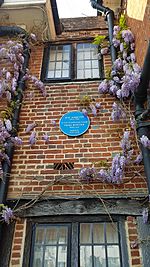Mill House and The Wharf, Sutton Courtenay facts for kids
Quick facts for kids Mill House |
|
|---|---|

Mill House in 2015
|
|
| Type | House |
| Location | Sutton Courtenay, Oxfordshire |
| Built | 1913 with earlier origins |
| Architect | Walter Cave |
| Architectural style(s) | Vernacular |
| Governing body | Privately owned |
|
Listed Building – Grade II
|
|
| Official name: The Wharf | |
| Designated | 9 February 1966 |
| Reference no. | 1052730 |
|
Listed Building – Grade II
|
|
| Official name: Mill House | |
| Designated | 6 August 1952 |
| Reference no. | 1368101 |
|
Listed Building – Grade II
|
|
| Official name: Walton House | |
| Designated | 9 February 1966 |
| Reference no. | 1284624 |
|
Listed Building – Grade II
|
|
| Official name: Wharf Barn | |
| Designated | 9 February 1966 |
| Reference no. | 1182296 |
| Lua error in Module:Location_map at line 420: attempt to index field 'wikibase' (a nil value). | |
The Wharf, Walton House and Mill House are three important houses in Sutton Courtenay, Oxfordshire, England. They were once part of a large country home owned by Margot Asquith. She was the wife of H. H. Asquith, who was the Prime Minister (the leader of the British government) from 1908 to 1916. Margot bought and expanded these buildings starting in 1911. The family used them as their country home until H. H. Asquith's death in 1928.
The architect Walter Cave helped with the renovations and expansions. Friends and admirers of Margot Asquith helped pay for the work. Margot sold the property in 1932, and since then, the houses have been owned separately. In 2006, the actress Helena Bonham Carter, who is Asquith's great-granddaughter, bought back Mill House. All three properties are special because they are Grade II listed buildings. This means they are protected because of their historical importance.
A Look Back: The History of the Houses

Margot Asquith bought The Wharf from her friend Maud Tree in 1911. A rich banker named J. P. Morgan helped her with the money. In 1917, she bought Mill House to have more space for guests. This time, Lady Boot, whose husband founded the famous "Boots" chemist shops, provided the money. Walter Cave was the architect for all these changes.
When the Asquiths lived there, Sutton Courtenay was in Berkshire. This changed in 1974 when the county borders were redrawn. H. H. Asquith loved spending his weekends at The Wharf. He passed away at the house on February 5, 1928. In 1932, Margot sold the house because she had money worries. In 2012, Asquith's great-grandson, Raymond, put up a Blue plaque at The Wharf. This plaque is a special sign that tells people about important historical figures who lived there.
In 2006, Mill House was bought by the famous actress Helena Bonham Carter. She is H. H. Asquith's great-granddaughter. Her partner at the time, director Tim Burton, also bought it with her. In 2007, The Wharf was put up for sale.
What the Houses Look Like
The architect Walter Cave designed the changes to the houses. His style is sometimes called "neo-William-and-Mary." This means it looked a bit like buildings from the late 1600s and early 1700s.
The Wharf is a two-story house. It is built with red bricks laid in a pattern called "English bond." Mill House is also made of brick. It was built in the 1700s, but parts of it are even older. Cave added more sections to it later. Walton House is also made of red brick, but its bricks are laid in a "Flemish bond" pattern. It dates from the early 1800s, and Cave also added his own touches to it.
In 1913, a barn on the grounds of The Wharf was changed by Cave. It overlooks the River Thames and became a quiet place for Margot Asquith to relax. All three houses – The Wharf, Mill House, and Walton House – are Grade II listed. The Barn is also a Grade II listed building. This means they are all recognized as important historical buildings.

